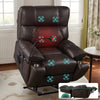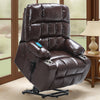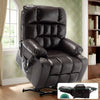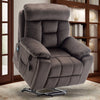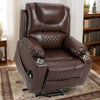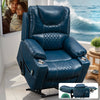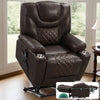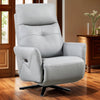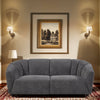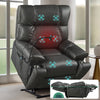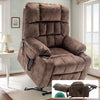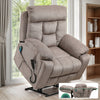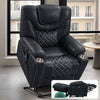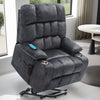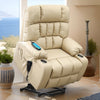The Essential Guide to Power Lift Chair Selection
Understanding the Various Types of Power Lift Chairs
Power lift chairs come in several types, each designed for specific needs. Two-position chairs offer basic recline and lift functions. Three-position chairs add a TV-watching position. Infinite-position chairs provide the most flexibility, allowing various positions. Zero-gravity chairs offer a weightless feel, reducing pressure on the spine. Lay-flat models recline fully for sleeping. Some chairs have extra features like heat and massage. When choosing, consider your needs, room size, and health conditions. Each type has its benefits, so it's important to explore all options before deciding.

Key Features to Look for in a Power Lift Chair
When selecting a power lift chair, several key features are worth considering. Look for durable upholstery that's easy to clean. Check the weight capacity to ensure it suits your needs. Quiet, smooth motors are essential for comfort. Consider the controller type - some prefer simple buttons, others like remote controls. Backup battery systems are crucial in case of power outages. Look for adjustable headrests and lumbar support for added comfort. Some chairs offer USB ports for charging devices. Memory foam cushions can provide extra support. Always test the chair's lift mechanism to ensure it meets your mobility needs.
The Importance of Safety and Comfort
Safety and comfort are paramount when choosing a power lift chair. Look for models with anti-tip mechanisms to prevent accidents. Ensure the chair has a stable base and smooth lift action. Check for pinch-point protection to avoid injuries. The chair should have easy-to-use controls, even for those with limited dexterity. Comfort features like padded armrests and footrests are important. Consider the seat depth and width to ensure a good fit. Some chairs offer heat and massage functions for extra comfort. Always check the weight capacity and make sure it exceeds your needs. Remember, a safe and comfortable chair can greatly improve quality of life.
Enhancing Home Aesthetics with Power Lift Chairs
Choosing the Right Design for Your Living Room
Selecting a power lift chair that complements your living room decor is crucial. Consider the overall style of your space - modern, traditional, or eclectic. Choose a chair color that harmonizes with your existing furniture. Leather chairs often suit traditional rooms, while fabric options work well in casual spaces. Look for sleek designs if you have a modern aesthetic. Some chairs come with wooden accents that can match your coffee table or shelving. Consider the size of your room and ensure the chair doesn't overwhelm the space. Remember, the chair should blend in, not stand out as medical equipment.

The Role of Power Lift Chairs in Ergonomic Home Design
Power lift chairs play a significant role in creating an ergonomic living space. They provide proper support for the back, neck, and legs, promoting better posture. The lift function helps reduce strain when standing or sitting. Consider how the chair fits into your daily routine. Place it where you spend most of your time, ensuring easy access to other furniture. The chair should allow for comfortable TV viewing or reading. Some models swivel, which can be useful in open-plan spaces. Remember, an ergonomic setup not only improves comfort but also enhances overall well-being.
Customization Options for Power Lift Chairs
Many power lift chairs offer customization options to suit individual needs and preferences. Fabric choices range from leather to microfiber in various colors and patterns. Some manufacturers allow you to choose the firmness of cushions. You can often select the type of controller that's easiest for you to use. Some chairs offer interchangeable arm and headrest covers for easy updates. Custom sizing is available for those with specific height or weight needs. Add-on features like cup holders or side pockets can enhance functionality. Remember, customization can help your chair feel less like a medical device and more like a cherished piece of furniture.
Implementing and Maintaining Your Power Lift Chair
Installation Tips for Power Lift Chairs
Installing a power lift chair correctly is crucial for its proper function and your safety. First, choose an appropriate location with enough space for the chair to fully recline. Ensure there's a power outlet nearby, but avoid using extension cords for safety reasons. If the chair comes in parts, follow the assembly instructions carefully. Some models may require professional assembly. Place the chair on a level surface to prevent rocking or tipping. Test all functions after installation to ensure everything works smoothly. If you're unsure about any step, don't hesitate to contact the manufacturer or a professional for help.

Regular Maintenance for Longevity
Regular maintenance can significantly extend the life of your power lift chair. Vacuum the chair regularly to prevent dust buildup. Clean spills immediately to avoid staining. For leather chairs, use appropriate leather cleaners and conditioners. Fabric chairs may benefit from fabric protector sprays. Lubricate moving parts as recommended by the manufacturer. Check and tighten screws and bolts periodically. Inspect the power cord for any signs of wear. Clean the remote control with a slightly damp cloth. If your chair has a battery backup, check and replace it as needed. Always refer to your user manual for specific maintenance instructions.
Troubleshooting Common Issues with Power Lift Chairs
Even with proper care, power lift chairs may occasionally have issues. If the chair doesn't lift, check if it's plugged in and the outlet is working. Ensure the hand control is connected properly. If the motor is noisy, it may need lubrication or replacement. For jerky movements, check for obstructions in the mechanism. If the chair stops mid-motion, it may be a safety feature activating - check the manual. For remote control issues, try replacing the batteries. If heat or massage functions fail, check their connections. For persistent problems, contact the manufacturer or a professional technician. Remember, never attempt repairs beyond your skill level, as it could be dangerous.








